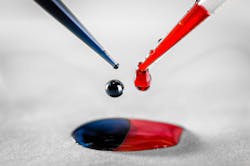No Doping: Producing a Conducting Ink Without Foreign Substances
Scientists have succeeded in producing a conducting ink, consisting of two polymers, that does not require any “doping” to conduct electricity.
Plastics are polymers that are typically used in electrical and electronic applications as insulators. Conducting polymers, in contrast, become electrically conductive when electrons are removed (through oxidation) or introduced (through reduction) to create single and double bonds between carbon atoms in the polymer’s chain-like structure.
Scientists refer to this process of adding a donor or acceptor molecule to the polymer as “doping,” but the reaction is actually a redox reaction. Polymers can be doped with various substances to increase electrical conductivity.
Doping has been used in practical applications, such as solar cells, light-emitting diodes, shields for computer screens that guard against electromagnetic radiation and other bioelectronic applications. A device’s performance and conductivity can be manipulated by increasing the number of charges (either removing an electron or donating it to the semiconductor material with a dopant molecule).
One of the downsides of doping is that the process is stable only for a while. As materials degenerate, the substances used as doping agents can leach out, explained associate professor Simone Fabiano, head of the Organic Nanoelectronics group within the Laboratory of Organic Electronics at Linköping University. “This is something that we want to avoid at any cost in—for example—bioelectronic applications, where the organic electronic components can give huge benefits in wearable electronics and as implants in the body,” said Fabiano.
The research team succeeded at creating a new organic material by mixing two polymers with different properties. The energy levels of the two materials match perfectly, so that charges are spontaneously transferred from one polymer to the other, noted Fabiano.
“The phenomenon of spontaneous charge transfer has been demonstrated before, but only for single crystals on a laboratory scale,” he said. “No one has shown anything that could be used at an industrial scale.”
Polymers consist of large and stable molecules that are easy to deposit from solution, which makes it well suited for large-scale use as ink in printed electronics, noted Fabiano.
Polymers are simple and relatively cheap materials, and are commercially available. But the appeal of the new ink rests on several properties, including:
- No foreign substances leach out from the new polymer mixture.
- It remains stable for a long time and withstands high temperatures. These properties are important for energy harvesting/storage devices as well as wearable electronics.
- Since the new polymer mixture is free of doping agents, it is stable over time and can be used in demanding applications.
“The discovery of this phenomenon opens completely new possibilities for improving the performance of light-emitting diodes and solar cells. This is also the case for other thermoelectric applications, and not least for research within wearable and close-body electronics,” said Fabiano.
The results have been published in Nature Materials.
Fun Fact: Plastics That Conduct Electricity
The Nobel Prize in Chemistry 2000 was awarded jointly to Alan J. Heeger, Alan G. MacDiarmid and Hideki Shirakawa “for the discovery and development of conductive polymers.” The discovery was considered a major breakthrough in the field of polymer science. Since then, the field has evolved substantially and has led to myriad new applications.
About the Author

Rehana Begg
Editor-in-Chief, Machine Design
As Machine Design’s content lead, Rehana Begg is tasked with elevating the voice of the design and multi-disciplinary engineer in the face of digital transformation and engineering innovation. Begg has more than 24 years of editorial experience and has spent the past decade in the trenches of industrial manufacturing, focusing on new technologies, manufacturing innovation and business. Her B2B career has taken her from corporate boardrooms to plant floors and underground mining stopes, covering everything from automation & IIoT, robotics, mechanical design and additive manufacturing to plant operations, maintenance, reliability and continuous improvement. Begg holds an MBA, a Master of Journalism degree, and a BA (Hons.) in Political Science. She is committed to lifelong learning and feeds her passion for innovation in publishing, transparent science and clear communication by attending relevant conferences and seminars/workshops.
Follow Rehana Begg via the following social media handles:
X: @rehanabegg
LinkedIn: @rehanabegg and @MachineDesign


